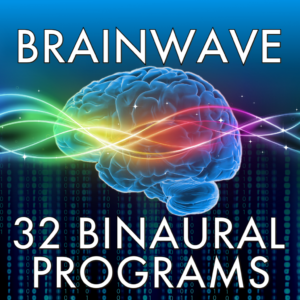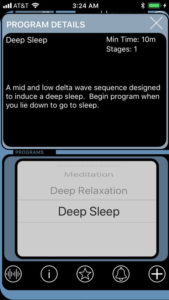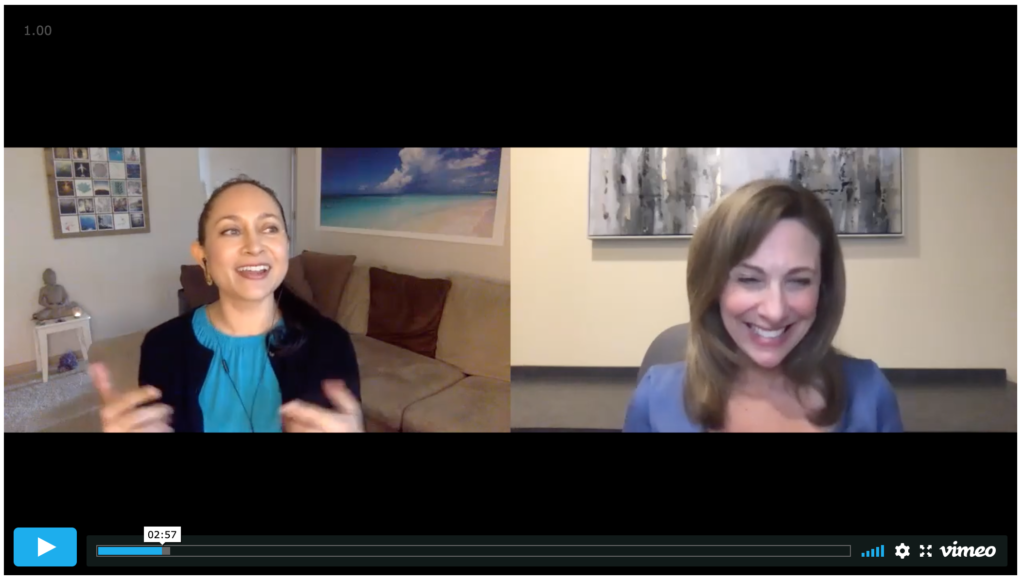
Uma Sanghvi helps people release fear & anxiety, connect with their Higher Self wisdom and live a radiant life of rest and joy.
Have you ever had the experience of being so excited that you couldn’t sleep at night?
I have.
Do any of these scenarios sound familiar:
- you have a big meeting or presentation the next day
- you’re excited about a creative project
- you’re traveling in the morning
- you just got great news
All good stuff! But here’s the thing:
Excitement and anxiety feel very similar to the body.
If we’re prone to feeling anxious, then excitement can feel too close to anxiety for comfort. They are both high-arousal emotions: in both cases our heart rate goes up, adrenaline gets released, we may sweat and all kinds of other physiological changes happen that can disrupt our sleep cycle.
Being an empath means that I feel everything intensely. For a highly sensitive person (HSP) like myself, the volume is turned way up on emotions, sensations and information. For us empaths and HSPs, life is quite the adventure!
When it comes to feeling joy, this means that I experience massive joy from the smallest things. It’s wonderful.
But being an empath also means that overstimulation and discomfort are a frequent part of my life.
Dr. Judith Orloff, author of The Empath’s Survival Guide (and life-long empath) writes:
“We are so sensitive that it’s like holding something in a hand that has fifty fingers instead of five. We truly are super responders.”
I love that description.
Are you a super responder? Do you feel like you have fifty fingers instead of five?
One of the times I feel over-stimulated is when I’m super excited about something. Being too excited to sleep feels like getting stuck “on” and not being able to turn “off”. It feels like my body got hijacked by my mind + thoughts.
In a nervous system that’s dysregulated, it’s easy to get stuck in an activated state, whether that’s excitation or anxiety. Both feel like fight-or-flight. There’s too much energy bouncing around the system. Too much adrenaline. Too much cortisol.
As neuroscientists have discovered, a dysregulated nervous system is the result of trauma. And the loss of rhymicity is a hallmark of trauma. What kind of rhythms am I speaking of? Think of our daily human rhythms: working and playing, giving and receiving, waking and sleeping. These are some of the essential rhythms that get disrupted when trauma gets stuck in our body.
As we do the work of healing our nervous system, it becomes easier to modulate our excitation and relaxation energies. We may get super excited about something (or anxious) but because we have a healthy nervous system, we’re able to return to a resting state. And then it’s easier to fall asleep.
It’s great to feel excitement! But getting stuck in that state without being able to hit the “OFF” switch is a sign of a dysregulated system. When we heal our nervous system, our healthy daily rhythms come back.
Here are six tools to use to soothe your nervous system when you’re trying to get to sleep:
- EMBODIMENT
Do anything that helps get you out of your head and down into your body.
(This doesn’t mean high impact movement like cardiovascular exercise.)
It means being able to feel your life force energy. In traditional eastern medicine, this subtle energy is called prana or chi.
Doing yoga or qi gong can help you become present to the subtle energy of your body, as long as you are deeply aware of your body as you move. But there are even easier ways than that to return to your body.
One of the simplest embodiment tools is a body scan. The language of the body is sensation. Simply notice what visceral sensations are in your body right now. Muscle tension is one kind of sensation in the body. But there’s another more subtle kind of sensation, and that’s your life force energy.
This energy can feel like tingling, tightness, expansiveness, warmth, coolness. It can have a color associated with it or an object. For example, feeling butterflies in your stomach, a knot in your chest or a constriction in the throat.
Do whatever you can do to bring your focus out of your thoughts and down into your body. Simply feeling your feet, wiggling your toes, and sensing the textures against your feet will help to bring your awareness downwards.
Grounding exercises are particularly useful when there’s excess energy in the system (as is the case during anxiety and excitement). If you’re an empath, grounding is even more important.
If you want to play with grounding techniques, click here to download 10 Powerful Grounding Techniques to Relieve Anxiety & Achieve Calm.
- ALLOW, ALLOW, ALLOW
What we resist, persists.
The most powerful step in dissolving any kind of discomfort is learning how to sit with it. And not push it away.
Ironically, that is what allows the discomfort to dissolve.
But what does it really mean to sit with discomfort? What does it mean to be present with anxiety, in this case?
First and foremost, it means embodiment. Once you’ve done a body scan or a grounding exercise and feel connected to the visceral sensations in your body, see if you can identify where the most intense sensation in your body is located. This is the raw energy behind the anxiety/excitement you currently feel.
Become deeply present with your body and feel the sensations of excitement. Is your heart pounding? Is there a fluttery feeling? Are you clenching your muscles? Just notice what you notice.
Let go of trying to analyze your feelings. Let go of words completely and come back to feeling the raw energy.
Give your body permission to be exactly as it is in this moment. Talk to yourself as if you would talk to a friend feeling the same thing. Send compassion (not criticism).
Allow, allow, allow.
What we resist, persists.
- CALMING HOLD
I love this ancient technique for calming down!
This one comes from Jin Shin Jyutsu (pronounced “jin-shin-jit-soo”) – an ancient Japanese practice (similar to acupressure) of harmonizing the life force energy in the body.
Take your right hand and put it just under your left arm pit – on your ribs. Your hand should be level with your heart.
Take your left hand and put it on your right shoulder or just below the right shoulder.
And just hold. Feel the gentle connection. It’s not a squeeze.
Let yourself breathe. Don’t force yourself to breathe deeply. Just feel yourself breathing.
Give your body time to make the shift from excitement to calm. Be patient. Just listen inside.
Watch with gentle curiosity to see if anything shifts in your breath or your bodily sensations.
Bring your attention to your heart.How does it feel? In this self-hug, I sense my heart is protected and safe. A swaddled infant comes to mind.
Do you feel more slowed down? If you do, congratulations – this is what it feels like when your nervous system settles down.
- EXTEND YOUR EXHALE
Your breath is a powerful tool for soothing your nervous system. However, contrary to popular belief, taking deep breaths is not always a good idea. Forced deep breathing suppresses our emotions, and we actually want to allow our emotions.
Instead, try this. Start by bringing your attention to your exhale. Simply notice that you have an exhale.
When you reach a natural end point to your exhalation, invite the exhalation to go a little bit deeper. Without pushing or straining or clenching your muscles, simply see if you can exhale a little more breath, past your natural stopping point.
Not too much more. Just a little.
What you’re doing is making a little more room for the inhale.
And now become aware of the pause that happens between an exhale and an inhale.
Simply honor the pause that happens before a new inhale. You don’t need hold your breath out for a long time. Just notice the natural pause that occurs.
Just let your inhale come into your body naturally.
Try several rounds of breathing like this, and notice what happens in your system.
Remember: no forcing the breath. You’re simply inviting a slightly longer exhale. And pausing lightly before the inhale.
- USE BINAURAL BEATS
Anytime insomnia strikes, I highly recommend using binaural beats.
Binaural beats can induce a particular brain state. For example, when our brain is overactive, we emit a predominance of what are called beta waves. In the beta brain state, it’s harder to go to sleep. As we relax, our brain emits alpha waves. During light meditation, we also emit alpha waves. Different brain states (beta, alpha, gamma, theta, etc.) are correlated with certain mind-body states (i.e sleeping, awake, dreaming, calm, excited, creative, light meditation, deep meditation etc.)
There are many apps that sell binaural beat recordings. This happens to be the one that I use:


I LOVE this app for help with falling asleep!
It also has binaural beats for meditation, for reducing anxiety, for stimulating creativity and all sorts of other cool stuff.
Note: you must listen to binaural beats with headphones.
- USE A WEIGHTED BLANKET OR PILLOW
Studies show that weighted blankets are an effective way to reduce anxiety. Their heaviness literally pushes the body downwards, creating a sense of grounding.
I don’t own a weighted blanket, but I do have one of these three pound yoga bags.
If I’m laying down and trying to get to sleep, I place it on my thymus gland (on the upper part of the chest). If I’m sitting down, I’ll place it on my hands or on one of my thighs. It feels really good! For me, anxiety feels like floating up and away (like the house attached to the balloons in the movie UP). So using something heavy to weight me down feels great.
In yoga, some people put one on each hand during savasana (corpse pose).
* * *
So there you have it. Six ways to get your zzzz’s when you feel like you’re bouncing off the walls.
If you know of someone who suffers from insomnia, please share this article with them. Many popular insomnia remedies fail to work at the level of the nervous system. So it’s very likely that your friend hasn’t tried these techniques yet.
The good news is that we can re-balance our nervous system and feel healthy again, no matter how much stress or trauma we’ve been through. Resilience is part of being human. Our body and brain have an extraordinary capacity for self-healing. Our receptivity to feeling joy and love grows as we do this work of healing our nervous system.
Here’s to being happy and well-rested.
* * * * *
👉 Do you struggle with anxiety, stress and overwhelm? I can help.
👉 Click here to schedule a free discovery call with me.
* * * * *





